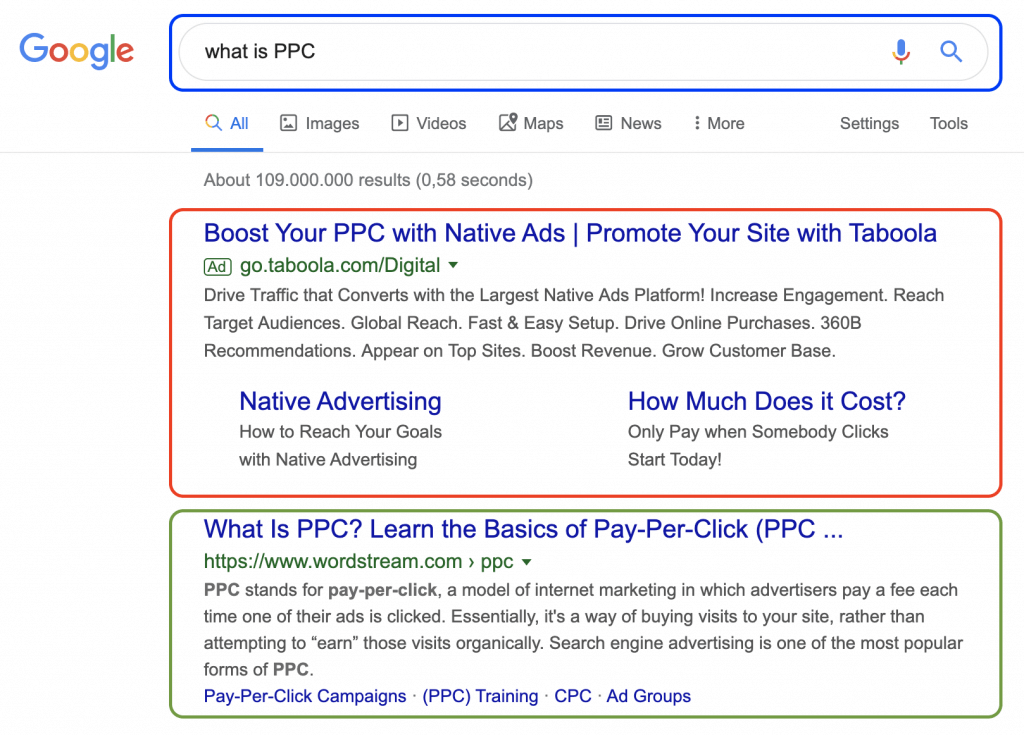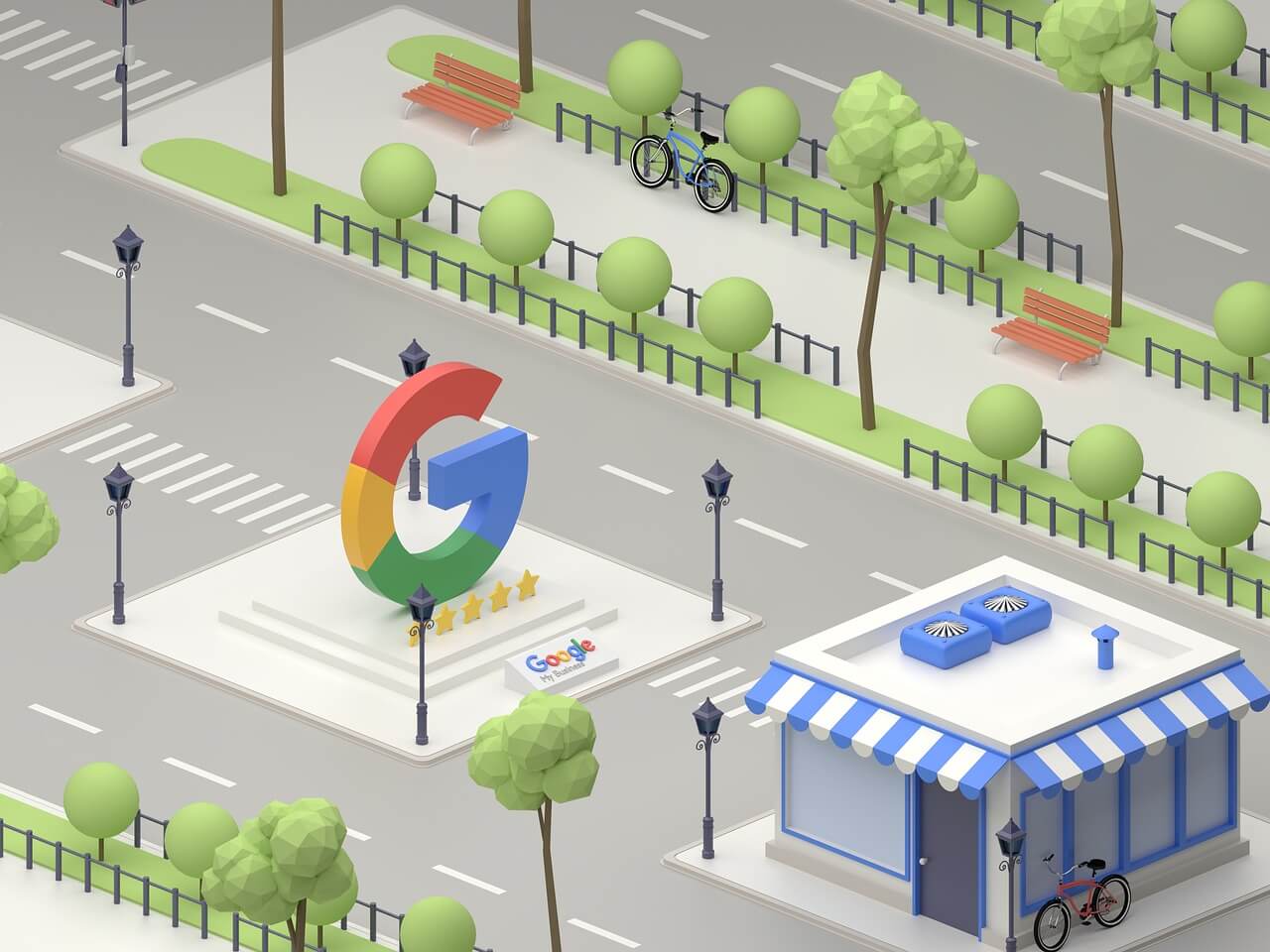SEO – Search Engine Optimisation and, PPC – Pay Per Click are both Search Engine Marketing strategies. In a nutshell, the difference between the two is:
- SEO: Website optimization to rank better and more frequently in search engines.
- PPC: Paying for your position on the SERP.
This blog will help you understand the basics of PPC so that you can run a successful Ad campaign.
Difference between SEO and PPC
You can see this difference best when dissecting the SERP. Below is an image of a random search query on Google.

- Search Query: This is whatever the user types (the initial problem)
- Search Ads: These are paid listings, which Google only charges if clicked.
- Organic Results: These are free spots – Ranking here will require time and optimization.
A successful PPC campaign is a dependant on understanding the possible search queries and appearing for the right audience.
Read more about SEO here.
SEO vs. PPC
SEO:
- Free SERP positions.
- To rank, you need to do search engine optimization. For example, you allow Google to crawl and index your website to increase your chance of matching with relevant search queries.
- Depending on the volume of competition, ranking on the first page of the SERP will take weeks and even months.
PPC:
- Paid positions. The price for the listing depends on several factors, like competitors and bids.
- You need to bid on keywords. Usually, the higher the rank, the higher the price you pay.
- You can appear on the first page of Google instantly.
Read more about PPC here.
PPC vs. Conventional Ads.
Conventional advertising includes all traditional outlets like billboards, newspapers, magazines, radio, and TV. All these outlets have in common that they are one ad broadcasted to many people.
With PPC, the situation is different. The customers are the ones searching for you or similar businesses using search queries. Hence, with PPC, there is already intent – when searching for a specific thing-. Moreover, with PPC, your ad can be customized according to the user’s environment, like his location, device, and demographics. For example, you could show different results for the same query based on the geo-location of the search alone.
The difference between PPC and Conventional marketing:
Expenses
The pricing scheme and rate are incredibly different. Conventionally, on TV or radio, advertisers compete for high-value positions. They pay a rate price for each spot. Besides that, there isn’t any rival engagement. PPC, on the other hand, is based on a blind-auction for positions on the SERP. The bid you place along with algorithm metrics (like relevance, authority, etc., read more about ranking here.) determines your rank on the SERP.
Restriction
There are more restrictions when it comes to conventional marketing. An ad you place on TV will be shown to all audiences, regardless of its relevance to them. The price rate paid for that position reflects the audience volume irrespective. Advertisers have more control with PPC. You can decide who you want your ad to be shown to, based not only on their search query. You can select based on location, times of day, and other preferences. Furthermore, you can even choose never to appear for specific keywords or phrases by adding them to the negative list.
Traceability
Tracking KPIs, like return-on-investment ROI, for conventional marketing, is an ordeal. It isn’t easy to trace the journey from the ad has been televised until the initial purchase. PPC is online; it allows you to track acquisitions as they happen, while every step is traceable. From the exact keywords in the search query to the volume and value of your purchases. PPC can also be integrated with offline channels to identify the precise amount of each campaign.
User Search Journey
There are four stages in the user’s search journey. Although this process is not necessarily sequential. A user can start at any stage. Understanding the user search journey will prepare you for creating successful ad campaigns.
Trigger
Typically, a user would type a search query as a reaction to a trigger. The trigger could be anything, from a TV ad or your dishwasher breaking down. The trigger puts you in a “need” state, consequently leading you to conduct your search.
Regardless of what the trigger is, whether its a fashion trend, new regulations, or an upcoming party, the reaction is one. The trigger drives users to react, do research, and then decide on how to meet the “need.”
Reaction
Once triggered, the most common response is to turn to Search Engines. Now, the initial search query might not have a commercial intent. Consider a faulty dishwasher being the trigger. The user might search phrases like, “How to repair a dishwasher?” Now the search might lack the commercial intent and is more informative, but it could very well lead to a business user journey.
The same can be valid for other triggers as well; a product advertisement could trigger the user. The user’s reaction might be Googling more information which is low intent. However, the response is always towards meeting the need that was triggered.
Research
At this stage, the prospect of a commercial user journey is much higher. Advertisers spend the lion-share of their search engine resources here. The user is actively searching for solutions that might include queries like:
- Clothe: “women’s winter jacket.”
- Repair: “quick smartphone repair.”
- Household: “how to get rid of stains.”
At this stage, the commercial intent is still accumulating. However, the search is still revolving around how to mee the need, and not who can fulfil the requirement. In other words, the user is still searching for information about how the problem can be solved and considering the different options. At the next stage, the possibilities will be funnelled down to make a choice.
Decision
The final stage of the journey is the decision. Here, the user is weighing all the different options and settling on the best one. The search queries will likely revolve around specific service providers or commercial shops. The above search queries at this stage would look something like this:
- Clothe: “Canada Goose winter jacket vs. Northface winter jacket.”
- Repair: “iPhone-Shop repair reviews.”
- Household: “best stain remover brand.”
These searches show a commercial intent and are probably the final stage of the user search journey.
Summing-up
Now you know the difference between PPC, SEO, and conventional marketing, and you also have an overview of a typical user search journey. Before you can create a rewarding ad campaign, there are a few factors that you have to recognize:
Campaign Strategy
There are four typical stages of the user search journey, some with more commercial intent. Should your campaign strategy focus on all stages or just the latter two, the research and decision? Maybe concentrate on steps with high commercial intention will have a better ROI for you. Having a single ad campaign for all stages tends to increase your spending without return. Search engines will likely show your ad to more users that have no commercial intent. Whatever you decide to do, ensure that you allocate your budget accordingly, and work out an allowance for each stage.
Ads
You have about three seconds to capture the user’s attention and make them click on your ad. Wording your ads efficiently will go a long way. Consider any call-to-action and ensure that the landing page reflects the CTA. Moreover, you need to tailor your ads based on the four phases of the user search journey. Targetting all users with the same ad message is more likely to incur unneeded costs. Having a specific ad message tailor to each group is best practice when it comes to ad creating.
Bidding
Now that you have most of your strategy down. It is time to start bidding on keywords and phrases. Making high bids on the first stages of the user search journey isn’t the best choice. At the trigger and reaction stage, you would want to make smaller bids. Place higher bids on the final stages, like the research and decision; this is where the user is more likely to purchase or convert.
You can even take bidding a step further, and target specific locations, demographics, and even certain times of day/week.
Leave a Comment
If you need more information, or maybe you need help growing your online presence or drive conversions, leave a comment below, or you can simply click here.


